A bear is wandering through the woods when, suddenly, a tiger leaps out from behind a nearby bush. The two animals square off with each other, neither side backing down or giving an inch of ground. The tiger came here for one reason, to hunt the bear and turn it into dinner. However, now that the tiger has shown its hand, the bear doesn’t intend just to roll over and die. Both of these apex predators will battle to their last breath. Now that it’s come to this, in a fight between a bear vs tiger, which of them would win?
Our first order of business is to decide which bear and tiger species will compete in this battle. After that, we’ll need to consider several factors and set some ground rules for the encounter. Next, we’ll compare seven critical attributes of each animal that will play a factor in the encounter. Based on this information, we’ll determine the winner between a bear vs tiger after playing out scenarios that could swing the fight in either animal’s favor.
Comparing Bear vs Tiger
Bears come in all shapes and sizes, from the tiny sun bears of Southeast Asia to the giant polar bears of the Arctic. As this is a hypothetical battle featuring the strongest members of each species, we can disregard factors such as geographical range. With this limitation removed, the polar bear will represent the eight extant species of ursids in this battle. It’s the largest bear species and the most predatory, making it a natural choice for this thought experiment.
Meanwhile, we must also select a tiger from the five remaining extant species. Of these species, the Siberian tiger is the obvious best candidate to represent its fellow felines. Also known as the Amur tiger, the Siberian tiger is the largest tiger species in the world. It’s the most capable of going toe-to-toe with a bear and one of the greatest stealth hunters on the planet. With our combatants chosen, it’s time to see how they measure against each other. We’ll compare seven critical offensive and defensive attributes that together will help us determine the outcome of the bear vs tiger fight.
| Polar Bears | Siberian Tigers | |
| Size | 7 feet, 10 inches to 9 feet, 10 inches long 770 to 1,500 pounds | 5 feet, 3 inches to 6 feet, 6 inches long 397 to 675 pounds |
| Speed | 25 mph | 40 mph |
| Bite Force | 1,200 psi | 1,050 psi |
| Teeth | 42 teeth Up to 1.96 inches long | 30 teeth Canines between 2.5 to 3 inches long |
| Claws | Claws 3.5 to 3.75 inches long | Up to 4 inches long |
| Stamina | Frequently swim up to 30 miles at a time Can run up to 1.25 miles without stopping | Can run at top speed for only 300 feet |
| Predatory Instincts | Ambush animals below the ice Walk down less mobile prey on land | Stalk and ambush prey from their blind spot Kill with a powerful bite to the neck or throat |
The 7 Key Factors in a Fight Between Polar Bears and Siberian Tigers
Polar Bear vs Siberian Tiger: Size
Based on their size, polar bears outclass Siberian tigers in terms of length and mass. Male polar bears generally average between 7 feet, 10 inches, and 9 feet, 10 inches long, and weigh from 770 to 1,500 pounds. However, especially large polar bears can reach up to 11 feet tall and weigh over 2,000 pounds. Meanwhile, most male Siberian tigers measure between 5 feet, 3 inches, and 6 feet, 6 inches long (without the tail), and weigh from 397 to 650 pounds. While large specimens can reach up to 10 feet long and weigh nearly 900 pounds, that means that even the largest Siberian tigers would be barely larger than the smallest polar bears. Given this information, the polar bear possesses an advantage when it comes to strength and size. Advantage: Polar Bear
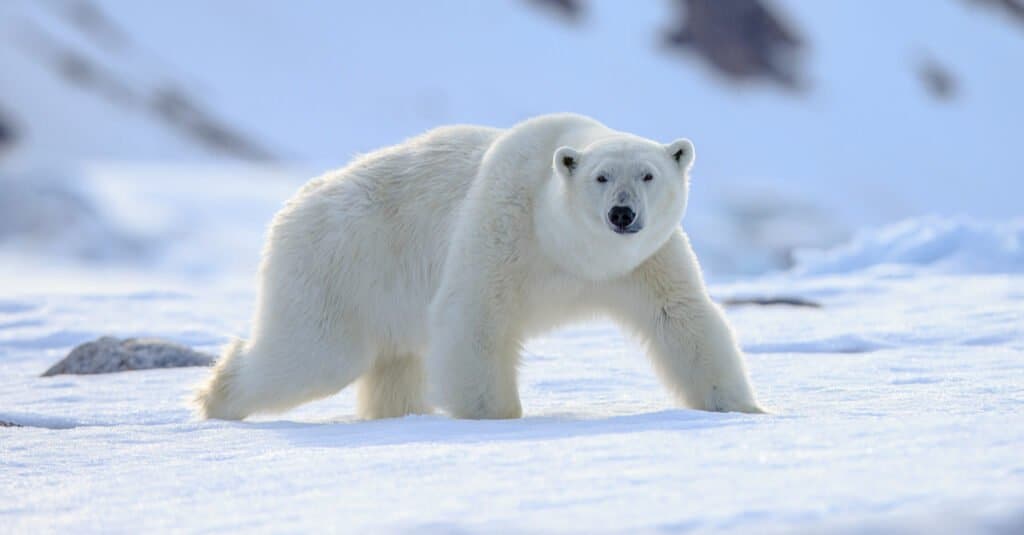
Polar bears are massive when compared to the Siberian Tiger, weighing more than twice as much.
©Vaclav Sebek/Shutterstock.com
Polar Bear vs Siberian Tiger: Speed
Although the polar bear may beat out the Siberian tiger in the realm of brute force, it can’t match a tiger’s pure speed or agility (at least on land). At top speed, polar bears can run nearly 25 miles per hour. However, its top speed pales compared to the Siberian tiger, which can reach speeds up to 40 miles per hour. That said, if this battle took place at sea, the polar bear would easily trounce the tiger with its top swim speed of over 6 miles per hour. Unfortunately for the polar bear, this battle will be fought on land, which means the tiger gains a distinct advantage with its lighter frame and quicker reflexes. Advantage: Siberian Tiger
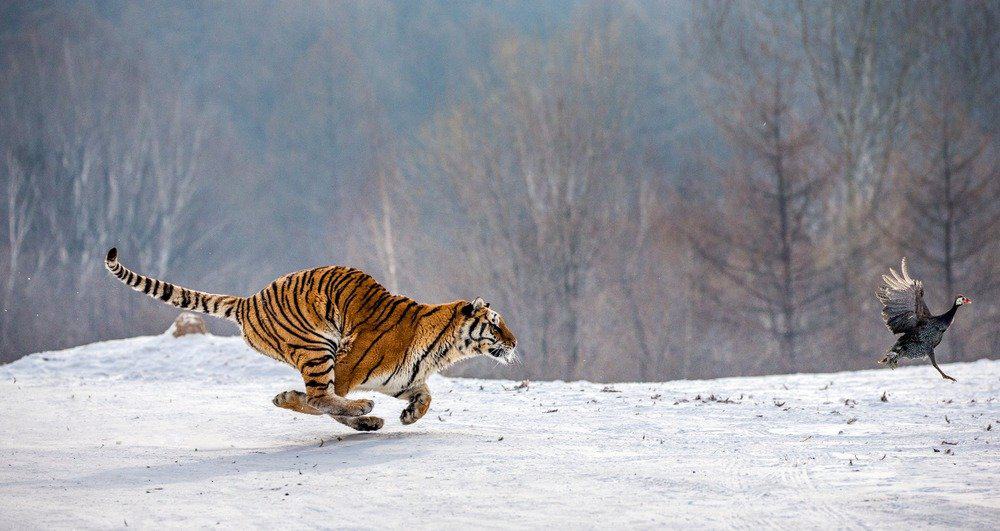
Siberian Tigers are impressively fast for their size.
©GUDKOV ANDREY/Shutterstock.com
Polar Bear vs Siberian Tiger: Bite Force
Polar bears and Siberian tigers both possess potent bites that can do severe damage to flesh and bones. With its massive skull, the polar bear can deliver over 1,200 psi per bite, which is strong enough to crack a whale’s skull. Right behind the polar bear in terms of strength is the Siberian Tiger. It delivers a maximum bite force of around 1,050 psi. Although tigers’ bite force is the greatest of any feline, the polar bear just barely retains the edge in this category. Advantage: Polar Bear
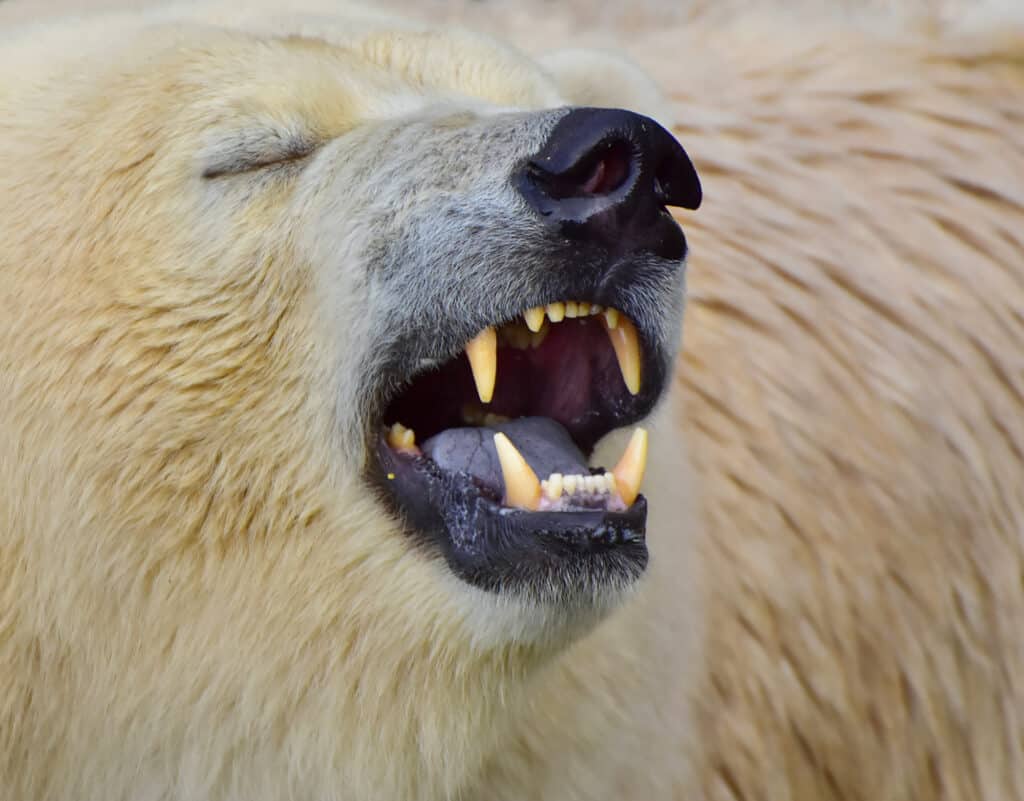
A polar bear’s jaws can inflict serious damage to anything in their range.
©Unicorn555/Shutterstock.com
Polar Bear vs Siberian Tiger: Teeth
As carnivores, both polar bears and Siberian tigers possess razor-sharp teeth designed to rip and tear flesh. However, the number of teeth that each animal sports and the lengths of those teeth vary. Like most canines, the mouth of a polar bear contains 42 teeth. These teeth range in size and can measure up to 1.96 inches long. They are designed to bite through the thick blubber and fat on whales and seals. While the Siberian tiger’s mouth only contains 30 teeth, its fangs dwarf the polar bear’s. Its canines can measure between 2.5 to 3 inches long, making them perfect for puncturing thick flesh. In short, a polar bear’s bite inflicts more points of impact, but the bite delivered by a Siberian tiger cuts deeper. Given that the tiger can inflict a deeper and more threatening wound, it gains a slight advantage. Advantage: Siberian Tiger

Siberian Tigers have teeth that are capable of inflicting deadly wounds with just one bite.
©Thorsten Spoerlein/Shutterstock.com
Polar Bear vs Siberian Tiger: Claws
Most bear species wield large but relatively blunt claws. Unlike other ursids, the claws of a polar bear are incredibly sharp. They can measure 3.5 to 3.75 inches long. In addition to helping them catch and hold onto prey, their claws provide traction, which helps them maintain their balance when running on icy terrain. However, the claws of a Siberian tiger belong in another class of sharpness. Their retractable claws can grow up to 4 inches long and are ridiculously sharp. They possess a wicked curve that allows the tiger to latch onto its prey and prevent any possibility or escape. Considering their size, sharpness, and shape, the claws of an Amur Tiger pose more of a threat. Advantage: Amur Tiger

This Amur Tiger is resting its head upon its paws, showcasing a glimpse of the deadly claws hiding within.
©iStock.com/Kathrine Andi
Polar Bear vs Siberian Tiger: Stamina
It would be fair to liken polar bears to the super athletes of the Ursidae family. They can swim for 30 miles in a single stretch, and some reports estimate they can swim up to 200 miles without resting. Additionally, younger, leaner polar bears can run at top speed for 1.25 miles, which only serves to solidify their incredible stamina further. On the other hand, Siberian tigers can only run at their maximum speed for around 300 feet. They are designed to execute short, explosive movements rather than conserve their energy for protracted conflicts. As a result, in a battle of attrition, the polar bear claims a decisive advantage. Advantage: Polar Bear
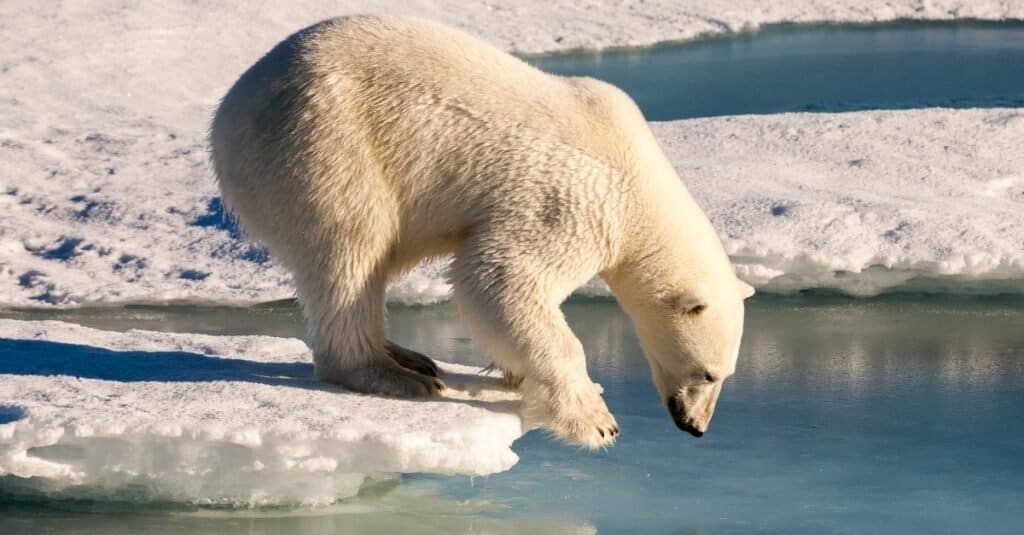
Polar bears have adapted incredible traits to help them survive in the harsh cold of the tundra.
©Mario_Hoppmann/Shutterstock.com
Polar Bear vs Siberian Tiger: Predatory Instincts
Both polar bears and Siberian tigers prefer to ambush their prey rather than attack head-on. Polar bears tend to wait upon an ice floe until an unsuspecting seal swims by, while Siberian tigers prefer to stalk their prey and attack from behind. In a land battle, the Siberian tiger possesses a distinct advantage. However, in an open field, removed of obstacles and any elements of surprise, the Siberian tiger’s advantages disappear. Polar bears frequently walk down large prey, including walruses, so they know how to attack foes in a straight-ahead battle. This is not the Siberian tiger’s forte, and as a result, the polar bear’s predatory instincts give it the advantage in a fight where surprise is not a factor. Advantage: Polar Bear
Final Tally: Polar Bear (4), Siberian Tiger (3)
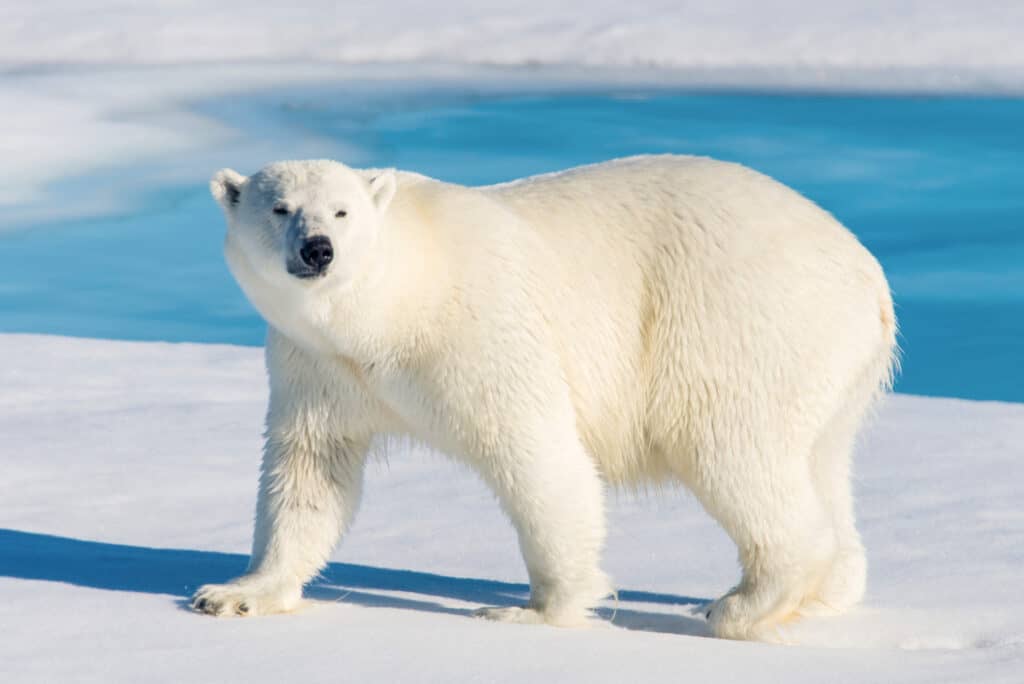
With its unmatched stamina and overwhelming size, a polar bear could easily defeat a Siberian tiger.
©iStock.com/Alexey_Seafarer
Who Would Win in a Fight Between a Polar Bear and Siberian Tiger?
If a Siberian tiger could catch a young female polar bear unawares, it could likely carry the fight. Their sharp claws, long teeth, and quick reflexes make them excellent ambush hunters. If a tiger could get its teeth around a bear’s jugular or on its spinal cord, it could quickly make short work of a smaller polar bear. However, the polar bear would likely win the battle in a head-to-head fight featuring two fully grown males. Their larger mass, stronger bite force, and greater stamina would allow them to outlast the smaller, weaker tiger. Eventually, the tiger would wear down, allowing the polar bear to put its considerable size to work. All it would take is one or two lucky swipes with its massive paws to put the tiger on its back and then a few bites to finish it off.
Frequently Asked Questions Concerning Bears and Tigers
Do tigers eat bears?
Tigers will eat any large prey they can catch and kill, including bears. Most often, the bears eaten by large tigers are young, female Himalayan bears. Even so, a young bear can put up a fight, so the tiger must take extra precautions when it decides to go after a bear.
Do bears eat tigers?
Studies suggest that bears will occasionally follow tigers in the hopes of stealing their kills and securing an easy meal. Such reckless behavior can cause the two species to clash. In some instances, the fight ends in the bear’s favor, in which case they will eat the tiger, although they don’t typically stalk tigers as prey.
How Long Do Bears Live?
Most species of bear live about one to two decades in the wild. Bear cubs mature to their full adult size somewhere around eight years old. Mother bears will accompany their cubs for their first 16-18 months of life.
The oldest bear who ever lived was a Polar bear named Debby who lived to be the ripe old age of 42. She spent most of her life at Assiniboine Park Zoo in Winnipeg. She was born in 1966 in the Soviet Union where she was orphaned as a cub. From the age of 1 until her death in 2008 Debby lived comfortably in her Canadian zoo.

Debby was known for being shy and gentle compared to other polar bears.
©GTW/Shutterstock.com
How Long Do Tigers Live?
Tigers usually live about 8-10 years in the wild once they reach adulthood. Sadly, approximately half of all tiger cubs do not live past the age of two. This is especially concerning to conservationists considering how endangered many species of tiger are.
The oldest known wild tiger was a Bengal tigress by the name of Machali. She exceeded her life expectancy significantly, living to be 20 years old, and making great contributions to the repopulation of tigers in her native region in Sawai Madhopur, India. Malachi was a local hero and legend, performing incredible feats such as the defeat of a 12-foot-long crocodile in battle.
The photo featured at the top of this post is ©
Thank you for reading! Have some feedback for us? Contact the AZ Animals editorial team.






